
|
REAP THE WILD WIND
The most beautiful game in the world.
Since the advent of MSN Messenger and
similar online chat programs, freelance journalists have lived in a sort
of virtual office. No longer isolated from the rest of humanity with
nothing but pizza boxes and bottles of Vanilla Coke for company, the
well-connected hack is only a line of typing away from sharing in
real-time conversation and banter with friends and colleagues (with
file-transferred MP3s serving as the office stereo, and no arguments about
who's turn it is to make the tea/get some vile
allegedly-blackcurrant-flavoured beverage from the drinks machine).
It was during such a conversation that your
reporter got to talking to a chum about the the strange chronology of
videogames journalism. Far more so than other cultures, games mags and
websites are utterly focused on the future (when did you last see a new
album repeatedly previewed for two years in a music paper?), concentrating
almost all of their coverage on games which aren't out yet and which, in
many cases, the journalists have never so much as glimpsed in action. Hype
is built up for months and years, reaching a fever pitch when the game's
about to come out. And then when it does, it gets a review that's shorter
than any of the preview features, and is never ever spoken of again. What's
that all about?
Partly, of course, it's to do with the way
games are sold compared to other media. While you can easily buy
20-year-old movies and records in any High Street store, buying a game
released more than six months ago is a near-impossible task. It's easy,
then, to understand why magazines drop new games like a hot potato the
minute they're actually available - once you've factored in the mag's lead
times, talking about a game more than one issue after the review is a
largely pointless exercise, since the chances are your readers won't be
able to go out and buy it any more. In this way, videogames magazine
readers are left constantly dissatisfied, endlessly told by the balance of
coverage that the stuff they can't play yet - won't be able to play for
anything up to two or three years, in fact -is where it's at, and
therefore logically the games that are out and available to buy right now
are worthless rubbish.
The games industry likes this state of
affairs just fine, of course. For one thing, it frees them of the
responsibility to have to maintain large back catalogues and the support
networks they entail. For another, it keeps customers salivating like
Pavlov's dogs for the very latest £40 new releases - and when something
depreciates in value as head-spinningly fast as a new videogame does (how
many times have you seen shelves of previously red-hot games being dumped
by game stores at 25% or even 50% discounts just a few weeks after their
initial release?), you need to have the punters buying it straight away.
But for anyone who actually cares about
games, it's a messed-up, arse-backwards way of doing things. A game's real
qualities often don't become fully apparent until you've been playing the
finished article for weeks, and by then there's simply no outlet for
talking about it any more. (Indeed, a magazine running a post-review
feature about a game and raising previously-unmentioned interesting points
and observations about it would tend to be seen by most editors as
undermining the authority of their original "definitive" judgement. And
with games magazines still almost universally defining themselves
primarily by their reviews, that's a potentially suicidal move.)
Even the tiny handful of magazines and
websites that attempt a slightly more sophisticated and intelligent form
of games journalism than "EXCLUSIVE! FIRST PREVIEW SHOTS INSIDE!!!" rarely
go back and write about a game with the benefit of a few months'
hindsight. Once in a blue moon you might be lucky enough to get a sort of
round-up (of the sort pioneered by Spectrum games mag Crash in the 1980s)
looking back at a few reviews and changing the scores by a few percent
here or there with maybe a few lines of discussion/justification, but
writers almost never get to go back and talk at length about a game -
indeed, chances are they never got to talk about the finished, production
version at
length at all.
(The chum your correspondent was talking to
about the subject was a writer for Edge, where even the biggest allocation
of review space will do well to stretch beyond 800 words (and for
reference, that's how long this piece has been wibbling on for already,
and we haven't even got to the basic point yet) and everything that makes
a game good or bad will more often have to be communicated to the paying
reader in somewhere closer to 200, which is barely the length of one of
this reporter's paragraphs. To any games journalist who wants to do their
job properly for its own sake, rather than just hurry up and get a nice
job in PR as soon as humanly possible, it's a frustrating and dispiriting
state of affairs.)
The luxury of a website like World Of
Stuart, then, is that none of the above applies. With no publishers
setting the editorial agenda, no physical limitation on how many words you
can fit on a page, and no obligation to be obsessed with the present and
future in order to placate advertisers who only want you to talk about
what they're hawking this minute and next month, the opportunity exists to
talk about any game at any length, until either you've said everything you
want to say about it or everyone's dead. So let's take advantage of that
opportunity, and talk about Tempest X3.
Tempest X3 is one of those unfortunate games
that fell between the cracks in the world of games and the gaming press.
It wasn't a big-money movie licence or sports franchise, so it got little
coverage in the mainstream games mags, and it wasn't original or
groundbreaking (being seen as basically just a slightly tweaked version of
Jeff Minter's original Tempest update Tempest 2000 on the Jaguar, though
it came out nearly three years later) so it was largely ignored by the
more "intellectual" elements of the gaming media too. (TX3 got just a
sixth of a page in Edge, for example - just 8% of the space that was given
to both Tempest 2000 and Minter's own Nuon follow-up Tempest 3000 which
came out four years after TX3. It may also be that T2000 and T3000 got so
much more coverage because they were written by one of gaming's sacred
cows rather than the anonymous in-house code monkeys at Interplay who did
TX3, but that's a whole other article.)
But Tempest X3 is actually a lot more than a
minor respray of Tempest 2000. For a start, it's considerably bigger,
offering 128 levels of abstract-spider's-web-based space blasting rather
than its predecessor's 100. What's more, the first 100 levels also contain
many new webs not seen in T2000. There are several entirely new enemy
types too (a substantial change when you consider that Tempest and T2000
only had about six different enemies in the first place, so adding four or
five new ones makes a pretty big difference), and a hidden "Trippy Mode" that's
still the most psychedelically mindblowing experience in the 25-year
history of videogaming. (To call it "trippy" is like pointing at a
Lamborghini Diablo and saying "Car".)
On top of this there's a purely aesthetic
respray too. The empty wireframe webs of T2000 are replaced with ones
filled with fluid textures, futuristic new fonts in gleaming white bring a
cleaner, sharper, more modern feel to the presentation, and the
Playstation's lighting effects are shovelled on unstintingly to create the
impression of an unscheduled explosion in a fireworks factory.
In truth, Tempest X3 is almost as different
from Tempest 2000 as Tempest 2000 was from the original Tempest. The core
gameplay might be the same, but there are so many extras, and so many
changes to existing elements, that to all intents and purposes it's a
whole new sequel rather than a slight update. (The Pulsars of TX3, for
example, are a far less fearsome adversary than their T2000 equivalents,
meaning you don't have to drop absolutely everything else in a terrified
panic when one makes it to the edge of a web. But they're balanced by
other new and tweaked enemies, so overall the newer game is every bit as
hard.) To drive home this point with a flourish verging on the
contemptuous, TX3 actually offers a complete port of T2000 as an
unlockable extra when you top the high-score table, and playing the two
games one after the other convincingly dispels the myth that they're the
same.
That said, however, the two games share a
common dynamic that's unchanged from 2000 to X3, and which does have to be
largely attributed to Minter's initial updating. The original Tempest
coin-op was an artistic tour-de-force, but at heart a pretty
unsophisticated game. By the time you'd got to level 20 or so, every
subsequent level was fundamentally exactly the same as the last, only a
little harder, and attaining high scores was a repetitive test of sheer
reflex and endurance. If you couldn't beat a particular screen in a
straight shootout, you were pretty much screwed. With T2000, Minter
perfectly judged the number, type and timing of power-ups to introduce,
and in doing so increased the game's depth of play tenfold.
There were now substantially different ways
to tackle any given stage. For example, the third power-up collected on every level is
usually the Jump capability. This allows the player's ship to spring up
off the web into the safety of space, free from the clutches of almost all
the enemies but still able to rain fire and death down on them. Novice or
frightened players can use their Superzapper smart bomb right at the start
of a level and be almost guaranteed to get the Jump before things start to
get nasty, enabling them to spend the level bouncing up and down like a
rabbit on a pogo-stick, firing like crazy, and still have a decent chance of
making it through the stage. The more expert player, though, can risk
taking on the first wave of enemy attacks without the protection of the
Jump, in the knowledge that on succeeding they'll have the all-powerful Superzapper to fall back on during the overwhelming onslaughts later in
the wave and hence have a better chance of surviving the level than their
more lily-livered compatriots.
(The Superzapper, incidentally, marks
another of the subtle but important
changes in the way the two games play.
In Tempest 2000 it wipes out every enemy on the screen almost instantly,
but in TX3 it takes a lot longer to destroy them one by one, giving it the
potential to kill more baddies who appear while it's going off, but making
it less useful as a panic button to fall back on in times of disaster,
forcing the player to use it more tactically and strategically.)
The bolder of these two theoretical players,
by staying on the web surface rather than spending most of their time
leaping into space, will also have a better chance of collecting the
other power-ups, one of which is the highly useful "AI Droid", an
invulnerable wingman who'll happily wade into even the roughest of enemy
infestations, guns blazing, while the player cowers whimpering in a quiet
corner, or just seeks a brief moment's respite to gather their shattered
nerves. And by extra-specially judicious shooting rather than just
blasting everything that moves, the talented player can also manipulate
the appearance and collection of power-ups so that the AI Droid will
actually be the first thing collected on the next stage, further rewarding
skilled play with increased chances of survival.
Such manipulation of the power-up crystals
(all of which are gained by shooting enemies or enemy shots), in fact, is
probably the cleverest of Minter's additions to the Tempest formula. In
the normal order of things, the sixth crystal released in any level will
be a warp token. Collecting three of these gives you access to the bonus
stages, which provide a calming danger-free break from the brutal
intensity of the normal levels and a chance to rack up thousands of points
and a free life or two. But the bonus stages aren't just a soothing rest
stop. Complete one and you get a big points bonus, but the game also skips
you ahead five levels. If there's a particular stage you just can't beat,
then picking up warp tokens on the previous levels gives you another way
to defeat it - bypass it entirely. (This reporter once spent an entire day
trying to get past the Jaguar game's horrendous Level 64 in such a way.)
Alternatively, you can dodge warp tokens in
order to save them up for bonus stages you're better at (the bonus stage
changes every time the core colour of the webs does). Or you can take
advantage of the fact that shooting enemy bullets earns you power-ups just
like shooting enemies does, and keep a green Spiker or two alive at the
end of a stage, picking off their bullets and spikes to earn more crystals
and get the warp tokens you need. (The game wises up to this tactic and
stops giving you crystals after a little bit, but picking up a warp token
or earning a starting AI Droid can make all the difference to your chances
of getting through the next screen.) By adding remarkably few elements to
the basic design, Minter vastly increased the scope with which the game
could be played, and the power-up system is the one part of T2000 that TX3
developers High Voltage left almost totally untouched.
But all this cleverness would be irrelevant
if it were attached to a dull game. And given that every level of T2000 or
TX3 is just a single-screen web with a few enemies coming up it at you,
surely it must be incredibly repetitive after the initial buzz wears off?
That it isn't is where the real heart of Tempest's gameplay genius lies.
Any idiot can design a dull game and then
pile feature after feature on top of it in an attempt to hide its dullness
from the player. Any fool can make a game so complex, with so many
controls and buttons and move combinations, that players feel a sense of
achievement and misguided appreciation simply from the act of learning to
play it. What separates the masters from the mediocre is to be able to
design a game so simple in concept, with so few basic elements, and so
easy to pick up that anyone can grasp the mechanics of it in seconds, and
then combine those few elements in so many ways and with such
perfectly-judged balance that no two consecutive screens present the same
challenge, and in which even the most practiced player is no more than a
fraction of a second's loss of concentration away from catastrophe.
The things that make T2000 and TX3 so great
are in large part the things that made the original Tempest so beloved of gamers
back in the 1980s - the webs themselves. It's the dizzying array of
abstract geometric designs that make the game so compelling, because even
50, 60 or 70 levels in, the game can still find something new to throw at
you. Some webs are tiny, with only eight or nine "channels", concentrating
a maelstrom of action into a tiny space of staggering savagery, whereas
some are so big that the entire complexion of the stage can change in the
time it takes you to race from one end to the other.
Some are circular, enabling the player to
spin round pouring a constant barrage of fire down each channel, while
others have dead ends which the player can make strongpoints of, sweeping
from one corner to the other and back again with the Jump function and
ensuring that there are always two channels free of Spikes to race down at
the end of the level or if the "OUTTA HERE!" crystal is collected, ending
the level suddenly. Some are even figure-eights, testing the most
spatially-agile of minds as the player tries to figure out which way is
left and which is right as they loop disorientatingly around.
Some levels are seen from "underneath",
forcing the player to swiftly adapt his perspective. Some have channels
which fold completely in on each other, creating a deadly double-sided
plane in which shots seemingly aimed right at an enemy pass down the wrong
side and miss entirely. Some webs have small "floor" sections and huge,
vertiginous sides on which enemy attacks are practically invisible unless
you climb to the very top and survey everything from the highest vantage
point. And some are wide, flat and relaxing-looking, which dissipates the
enemy attacks over a wide range without decreasing their ferocity any, and
hence stuns the player into disbelief when they are killed yet again on
such a simple-looking stage.
For despite the apparent repetitiveness,
this is a ferociously addictive game. Cleverly, continue points only
appear on every second stage, and only after a stage is completed. So for
example, if you lose your last life on Level 40, your restart point will
be on Level 39 (all restarts are on the last odd-numbered level
successfully completed), and you'll have to clear three full levels in
order to earn the next restart point on Level 41. In such a way, progress
is always tantalisingly close, but always challengingly distant.
(Each level is a self-contained microcosm of
this principle - the next reward is only a power-up crystal away, helping
the player defeat each stage step by step, yet at the same time providing
a tempting lure into danger. The warp token, for example, is accompanied
by a free automatic Superzapper blast, which can be a lifesaver by such an
advanced point in the stage, yet often requires dashing from the player's
hard-won safe spot in order to go and collect it. All the best games are a
delicate and constant balance between risk and reward, and T2000 and TX3
are that concept distilled to its purest essence. Every second of every
minute brings a life-or-death decision to be made.)
It seems almost cheap to comment on the mere
aesthetics of Tempest X3. The visual splendour is illustrated in the
pictures on this page, but the aural aspect is a legend in game-sound
circles - a cross between nosebleed techno and Nine Inch Nails, the
driving, pulsating music is accompanied by nerve-jangling shouts and
screams, and the perfectly-judged ingame effects are a vital and integral part of play,
forcing the player to pay attention with their ears as much as their eyes.
Your reporter would use the word "synergy", if it hadn't been made a
hanging offence.
But it is worth a comment on the
abstract aesthetic nature of the game, because in a modern age where
"realism" is supposedly the ultimate aim of developer and player alike,
it's fairly extraordinary for anyone to have put out a game like this,
where your ship is a letter "C" and your enemies are letter "X"s and "W"s.
(It's no coincidence that Tempest was the arcade game most successfully
converted to the ZX81 over 20 years ago.)
That all the Tempest games manage to convey
such a level of malevolence despite your adversaries being simple
geometric shapes with no faces, eyes, or voices is testament to the fact
that there's a lot more to giving enemies character than getting some
unemployed actor to scowl into a motion-capture machine. Even games like
Rez or Vib Ribbon gave players recognisably humanoid protagonists to
identify with, but here there's absolutely nothing human to hold onto,
except the knowledge that the C-ship is somehow "you" and that everything
else is evil and wants to kill you. You don't know anything about them -
all you know is that they're the enemy, and they must die.
The closest parallel to Tempest for
atmosphere and "story" would probably be the movie Tron - it's as if
your console itself is the sentinel of another, electronic, universe,
which it's trying to pull you into for some malicious reason. (And which
would also explain the characters being like mutated versions of the
iconic Playstation symbols.) That's why
the red Flippers don't just kill you if they make it all the way up the
web and get a hold of you - they drag you down into the screen, into the
alternative universe, into who knows what kind of hellish place. It's one
thing to get shot by a Spiker, blasted by a Fuseball or fried by a Pulsar,
but even though nothing about the aftermath of capture is depicted or
implied - hey, for all you know they just want to chat - somehow you can
feel in your gut that you really don't want these guys taking you
alive. Brrr.
Very few games are as timeless as Tempest
X3, which makes it doubly, blackly ironic that the videogames industry
places so little store by (indeed, is actively hostile to) timelessness.
But then, the videogames industry is run by fat, soulless businessmen who
care far less about videogames than they do about stock options and company
BMWs and pension plans and third-quarter pre-tax earning projections. Gamers
themselves have no such excuses. It isn't too hard, even now, to track
down a copy of Tempest X3 (and if you don't have a PS1 or a PS2, an image
file taken from the CD will run very nicely on the PC via emulation, with
a couple of non-fatal bonus-stage hiccups), and it'll reward such effort
as it takes a hundredfold. Even if the gameplay wasn't such a model of
perfection - and it is - this would be a thing of rare and extraordinary
beauty, a work of art such as the world of videogames sees maybe two or
three times in a generation. Get it, play it, and love it to the last beat
of your heart.
Comments? WoS Forum
|
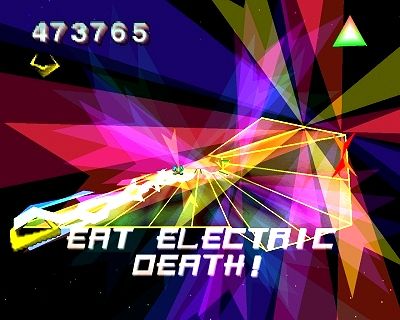
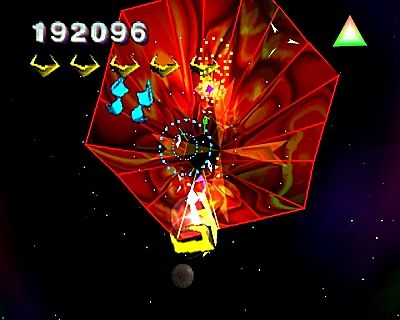
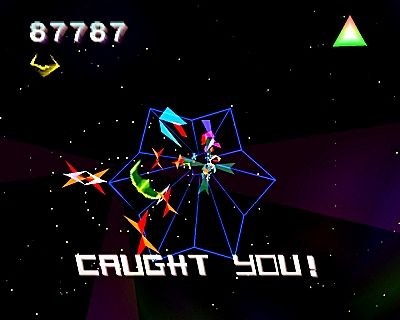
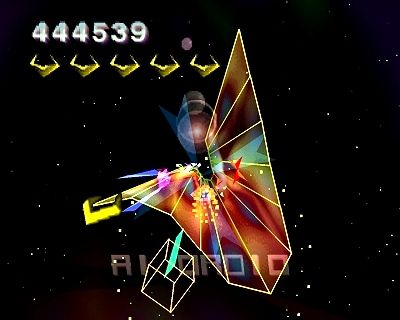
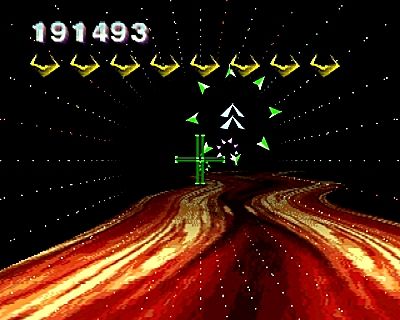
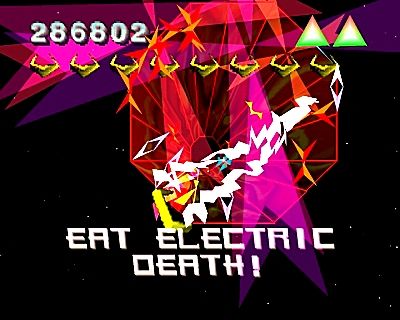
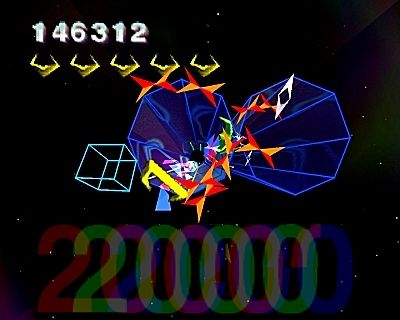
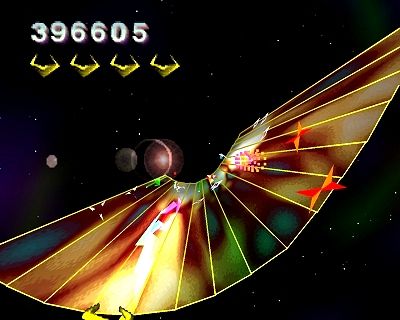
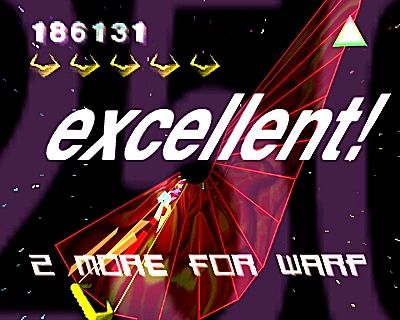
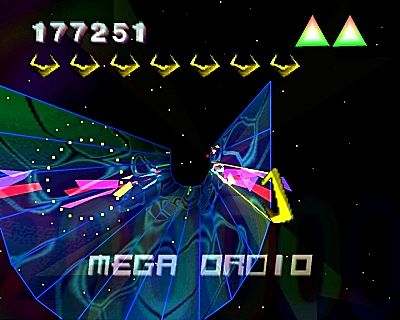
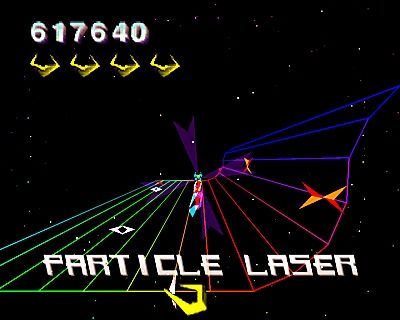

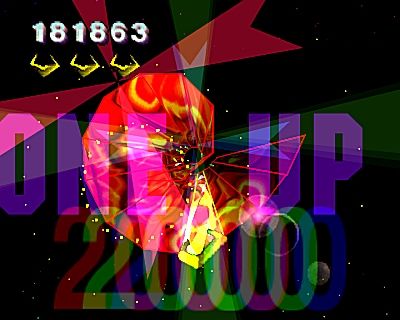
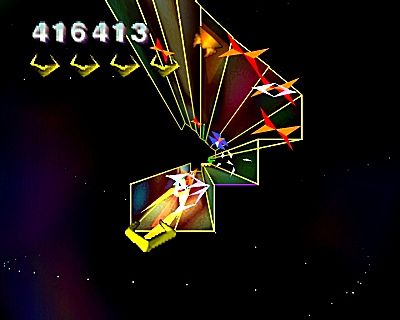
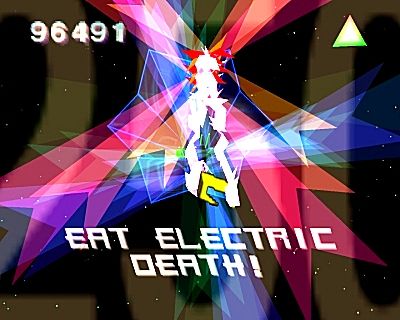
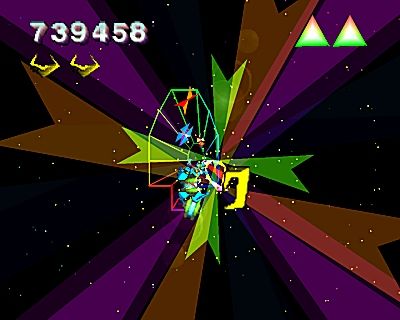
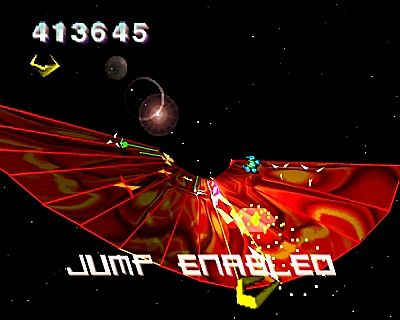
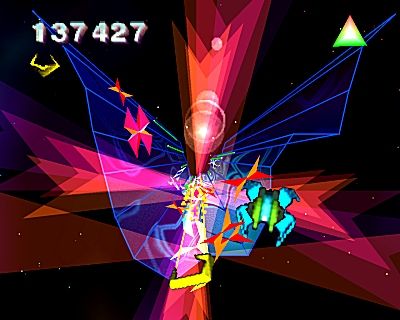
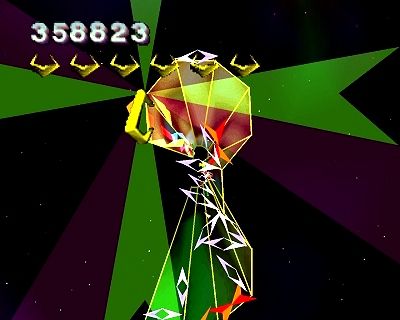
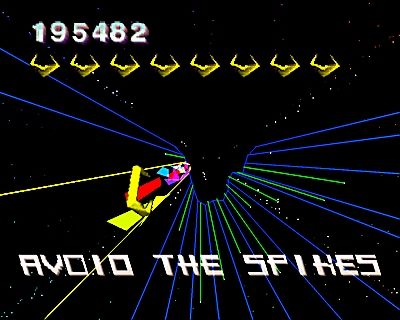
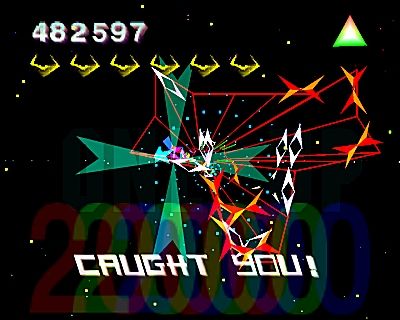 |